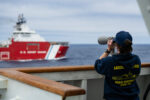At the Taipei Aerospace & Defense Technology Exhibition (TADTE) 2025, U.S. defense contractor L3Harris Technologies unveiled its new airborne early warning and control (AEW&C) concept dubbed “Phoenix.” Based on a modified Gulfstream G550 business jet platform and equipped with a dorsal radar array reminiscent of legacy E-2C/D Hawkeye designs, the Phoenix aims to provide a cost-effective and rapidly deployable solution for modern air surveillance and battle management missions.
Phoenix AEW&C Concept Overview
The L3Harris Phoenix is designed to fill capability gaps between high-end AEW&C platforms like Boeing’s E-7 Wedgetail and smaller ISR aircraft. The concept leverages the proven Gulfstream G550 airframe—already used by multiple nations for special mission roles—and combines it with an advanced dorsal radar system mounted atop the fuselage. This configuration evokes comparisons to Northrop Grumman’s E-2D Hawkeye but with modernized electronics and a smaller logistical footprint.
According to L3Harris representatives at TADTE 2025, the Phoenix is intended for customers seeking an affordable yet capable airborne command-and-control (C2) node that can operate within contested or constrained environments. The aircraft would be capable of long-endurance patrols while managing airspace surveillance and tactical data dissemination via multi-domain networks.
The company did not disclose detailed specifications such as radar type or detection range but emphasized modularity and open-systems architecture as key design features. This allows rapid integration of customer-specific sensors or communications suites depending on mission requirements.
Platform Choice: Why the Gulfstream G550?
The selection of the Gulfstream G550 as the host platform is both strategic and practical. The G550 offers high-altitude performance (up to FL510), long endurance (over 12 hours), and global support infrastructure due to its widespread civilian use. It also provides ample internal volume for mission systems while maintaining relatively low operating costs compared to larger platforms like the Boeing 737-based E-7A Wedgetail or Ilyushin Il-76-based A-50 Mainstay.
Notably, Israel has already fielded several special-mission variants of the G550 under its CAEW (Conformal Airborne Early Warning) program using EL/W-2085 AESA radar technology from IAI/ELTA Systems. Italy and Singapore also operate similar configurations. However, unlike those conformal designs that embed phased arrays along the fuselage sides, L3Harris opted for a dorsal rotodome-style antenna—a choice likely driven by cost considerations or specific customer preferences for 360° mechanical scanning coverage.
Radar Architecture and Sensor Integration
L3Harris has not publicly confirmed which radar system will be integrated into Phoenix; however, industry speculation points toward either an in-house development or collaboration with established radar vendors such as Northrop Grumman or Raytheon Technologies. The dorsal antenna suggests a mechanically rotating array rather than fully conformal AESA panels—potentially trading stealth profile for broader azimuth coverage at lower cost.
The aircraft is expected to feature multi-band datalinks (Link 16/STANAG-compliant), SATCOM connectivity, electronic support measures (ESM), identification friend-or-foe (IFF) interrogators/transponders, and onboard battle management workstations. Open architecture will also allow integration with national C4ISR networks or NATO-compatible systems depending on end-user requirements.
Target Markets: Indo-Pacific Focus
The decision to debut Phoenix at TADTE in Taiwan underscores L3Harris’ strategic targeting of Indo-Pacific customers concerned about regional airspace security amid growing tensions with China. Taiwan itself operates six E-2K Hawkeyes but has sought upgrades amid concerns about survivability against PLA anti-access/area-denial (A2/AD) threats.
Phoenix could appeal not only to Taiwan but also Southeast Asian nations like Indonesia or Malaysia seeking more affordable alternatives to full-size AWACS platforms while still enhancing their national air defense picture through improved situational awareness and sensor fusion capabilities.
L3Harris may also pitch Phoenix as a complementary asset within larger force structures—augmenting space-based ISR assets or acting as an airborne relay node during distributed operations under Joint All-Domain Command & Control (JADC2) concepts promoted by U.S. DoD planners.
Comparison with Existing AEW&C Platforms
- E-7 Wedgetail: Offers advanced MESA AESA radar on Boeing 737 platform; higher capacity but more expensive (~$1B per unit).
- E-2D Hawkeye: Carrier-capable with APS-145/AN/APY-9 radars; limited range/endurance compared to jet-powered options like G550.
- IAI/Gulfstream CAEW: Proven conformal AESA solution; stealthier profile but potentially narrower azimuth coverage than rotodome designs.
- L3Harris Phoenix: Mid-tier option balancing cost-effectiveness with modularity; suitable for nations without large AWACS budgets but needing persistent C4ISR presence.
Status of Development and Next Steps
The Phoenix remains a conceptual offering rather than a production-ready system as of Q4 2025. No launch customer has been announced publicly nor have flight tests been reported. However, L3Harris’ prior experience integrating mission systems onto business jets—including Compass Call EC-37B conversions—suggests technical feasibility is high once funding is secured from an interested buyer.
If adopted by Taiwan or another regional partner under Foreign Military Sales (FMS) channels or direct commercial sale agreements, initial operational capability could plausibly occur within three years given existing G550 availability on global markets.
Strategic Implications
The emergence of mid-tier AEW&C solutions like Phoenix reflects broader shifts in defense procurement priorities—favoring scalable architectures over bespoke mega-systems that are costly to maintain or replace under wartime attrition scenarios. As peer competitors field increasingly sophisticated anti-aircraft capabilities including long-range SAMs and counter-AEW tactics using jamming/drones/missiles, survivability through mobility becomes paramount—and smaller jets offer faster redeployment options than lumbering AWACS platforms.
Phoenix may not rival top-tier solutions in raw sensor power but could offer sufficient capability at one-third the price—a tradeoff many mid-sized militaries are likely willing to accept given budgetary constraints amid rising regional threats.









